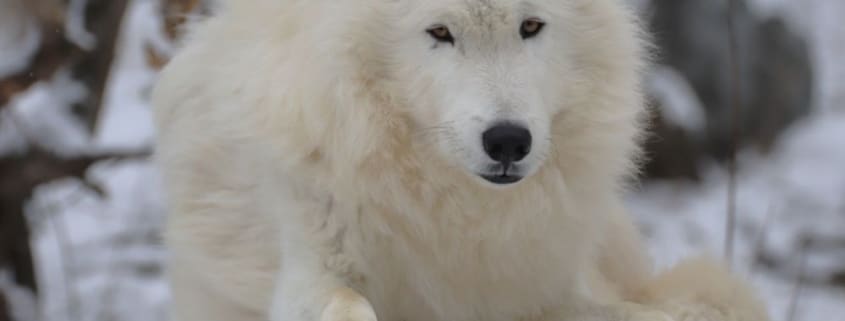Exhibit Pack Update – 1 January 2024
As we enter the new year, we look back at 2023 and review some of the highlights and key moments during the year:
January started off with the arrival of our curator-in-training, Giselle Narváez Rivera. She has been a perfect fit here at the International Wolf Center, and we could not be more pleased with the incredible work she has done thus far. She will be taking over as the role of Wolf Curator starting this month, still with the invaluable guidance of Lori Schmidt, Wolf Curator Emeritus.
By February we had seen Rieka growing confidence within the pack, but still displaying some juvenile behaviors with the yearlings, Caz and Blackstone. No doubt having younger individuals in the Exhibit Pack has given her the opportunity to engage in some of the social juvenile interactions that she missed out on being a singleton. The wolf care team also diligently monitored Axel’s coat condition, noticing discoloration and dryness that would eventually be determined as symptoms of a much larger issue.
March brought an abundance of snow. We had seen a lot of young wolf activity around the Exhibit Pack’s secondary fence to this point. Deep snowpacks can be tougher on younger animals compared to the more matured, experienced adults. Our wolf ambassadors had plenty of cover hay to help keep them warm, as well as multiple areas of shelter to utilize in inclement weather.
Caz and Blackstone turned one year of age in April, kicking off the start of our Ambassador Wolf Birthday Fundraiser. This fundraiser allowed us to install two additional surveillance cameras that aid us in monitoring the dynamics and safety of our wolf ambassadors. On cameras like these, we were able to observe Rieka oftentimes displaying dominance over Blackstone with a squash or a stand-over.
May is shedding season for wolves. Our ambassadors shed out their undercoats, some of which was saved to be made into products for our 2024 Wolf Care Auction. This auction will take place from February 26th to March 10th. The wolf care team noticed that Axel was not only shedding his undercoat like usual, but was also loosing guard hairs. We conducted a medical exam on both him and his littermate, Grayson. A diagnosis of sebaceous adenitis was determined and his treatment plan was developed.
During June, the bugs had arrived in swarms. This caused a lot of discomfort for our wolves, as many of the biting flies, gnats, and mosquitoes were relentless. We helped to ease this discomfort by opening the Wolf Care Center building for them to use as a place of refuge from the bugs and the heat. We also applied natural insect repellents such as cedar, peppermint, and lemongrass sprays.
To combat the heat of July, many frozen enrichments were provided to our wolf ambassadors. A favorite among the Exhibit Pack were buckets of snow given out during the 4th of July, colored red, white, and blue using sport drinks. The added electrolytes were beneficial in helping the Pack stay hydrated, although they seemed to prefer scent rolling on it rather than eating it.
In August, we began to see an increase of the displays of a maturing female from Rieka, as well as the rise of a lower-ranking pack member in Blackstone. Rieka’s increased dominance over the yearling seemed to mostly fall on Blackstone, with Caz being on the receiving end of more socially-motivated interactions. This really set the tone for Blackstone’s place as the omega of the Exhibit Pack.
September was the last month of heat, and the wolves were becoming pretty indifferent to the daily enrichments. To keep them interested and stimulated, the wolf care team worked hard to come up with unique enrichments for our wolf ambassadors to receive. One of those came in the form of a scarecrow made of frozen hay and a gourd for the head (topped with a bisonhide toupée). While Blackstone may be on the lower end of the rank order, he seemed the most confident approaching the novel item. Grayson, Caz, Axel, and Rieka were a bit more neophobic in their reactions, but eventually engaged in tearing it apart.
We had really started to see the tremendous improvement in Axel’s coat by October. His oral and topical treatments were successful in growing back a thick coat, as well as maintaining adequate moisture of his skin and hair. It was apparent that he would be well equipped to handle the cold and snow of the winter season.
November started out with us looking like we’d have a normal winter; there was a good coating of snow on the ground and the Exhibit Pack was certainly beginning to display the beginnings of winter dynamics. By late November, we had observed Grayson displaying more confidence in his interactions with the rest of the pack. He was more assertive, held his tail higher, and sought out Rieka frequently to engage in social behaviors.
When December came around, it was clear that we were not going to have a normal winter. Temperatures were unseasonably warm, there was no snow, and rain was a common occurrence. At the end of the month, there was finally another snowfall that stuck, providing a blanket of white in the Exhibit.
As we look back at the year behind us, we are so incredibly gratefully for all of the support shown toward IWC and our ambassador wolves. We look forward to what the wolves will teach us in 2024. To watch the video version of this Pack Update, click here.




